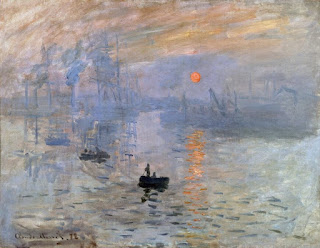The Romantic Era
From his bedroom window in November of 1872 while staying at the Hotel de l’Amiraute in Le Havre, Monet painted the southeast view of the harbor early in the morning. I like the calm mood projected in this painting with the coolness of the blue shades. The three fishing boats seem to glide smoothly over the gentle rippled texture of the water with the rising sun's deep orange reflection near them. Soon, the calm will be interrupted by the loud noises of construction in the background. I can imagine myself sitting at the window, enjoying a hot beverage, and taking a deep breath while bracing myself for the busy, noisy day to come. Monet was most likely trying to capture the peacefulness of the morning.
While
the armchair decorated with dainty flowers looks quite comfortable, the girl, dressed in a frilly dress with a sash and matching hair bow, seems to not
care that her portrait is being painted. Her facial expression looks like she
is quite bored. Her interest and pose are matched by the sleeping dog in the
chair nearby. The furniture in the back of the room looks inviting to the
visitor with deep curves in the upholstery indicating an overstuffed softness.
Although I like both of the above portraits, the impressionist style by Monet causes you concentrate to really see everything. You see vague impressions that take a little bit of work to bring into focus what the actual image is, whereas the portrait by Cassatt is clearer even though the lines are not sharp. It is easier to see details. I would like to think that even though the artist's original intention was to paint a proper portrait of her and her dog, after completing her preparations to start painting, she may have turned around only to find the girl like this, and decided to paint her as a child being a normal child instead of trying to portray her as something that others thought she should be.
John Everett Millais, Bubbles, 1886, oil on canvas (Unilever, on long loan to Lady Lever Art Gallery, Liverpool)
I liked this
painting for the relaxed pose of the lady resting with a twig in her mouth. While
doing research I came upon what I believe is the original painting and realized
that this was a corner of a larger painting. The larger one is of a group of
ladies and girls taking a break from walking in an apple orchard.
Their gowns
are painted with deep curves to show the volume and luxuriousness of the fabric.
The grass is a deep green and the apple blossoms in the background give it an
extra pop of pastel color and texture.
I put multiple citing for this to show the locations of both. To compare this to the Bubbles painting I would say they are similar in mood, showing a relaxing activity.
Dr. Beth Harris and Dr. Steven Zucker, "John Everett Millais, Spring (Apple Blossoms)," in Smarthistory, January 10, 2023, accessed March 26, 2024, https://smarthistory.org/john-everett-millais-spring-apple-blossoms/.
Bibliography
Lambourne, Lionel. Victorian Painting. New York & London: Phaidon (paperback), 2003.
Millais, John Guile. The Life and Letters of John Everett Millais, President of the Royal Academy. 2 vols. Vol. 2. New York: Frederick A. Stokes, 1899. Internet Archive. Web. 1 June 2011.
"'Spring' or 'Apple Blossoms,' 1859." Liverpool Museums. Web. Updated 6 October 2018.





.jpg)
I chose the same Monet painting. With a deeper dive and harder look at this painting, one can see Monet's meaning behind it. The intention here was to show the rise of the industrial age through the centralized sunrise.
ReplyDelete